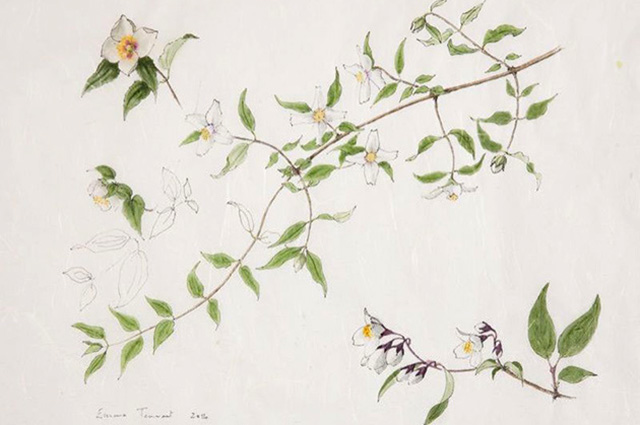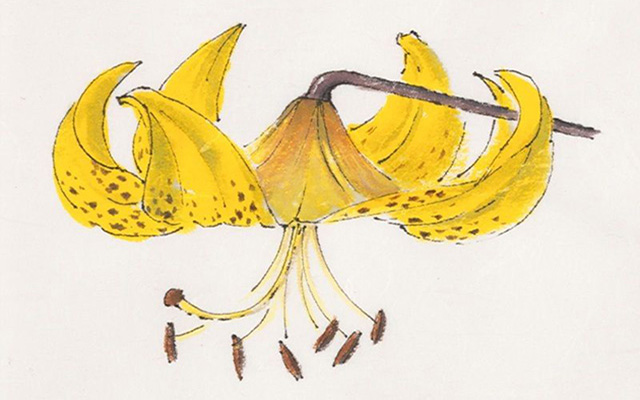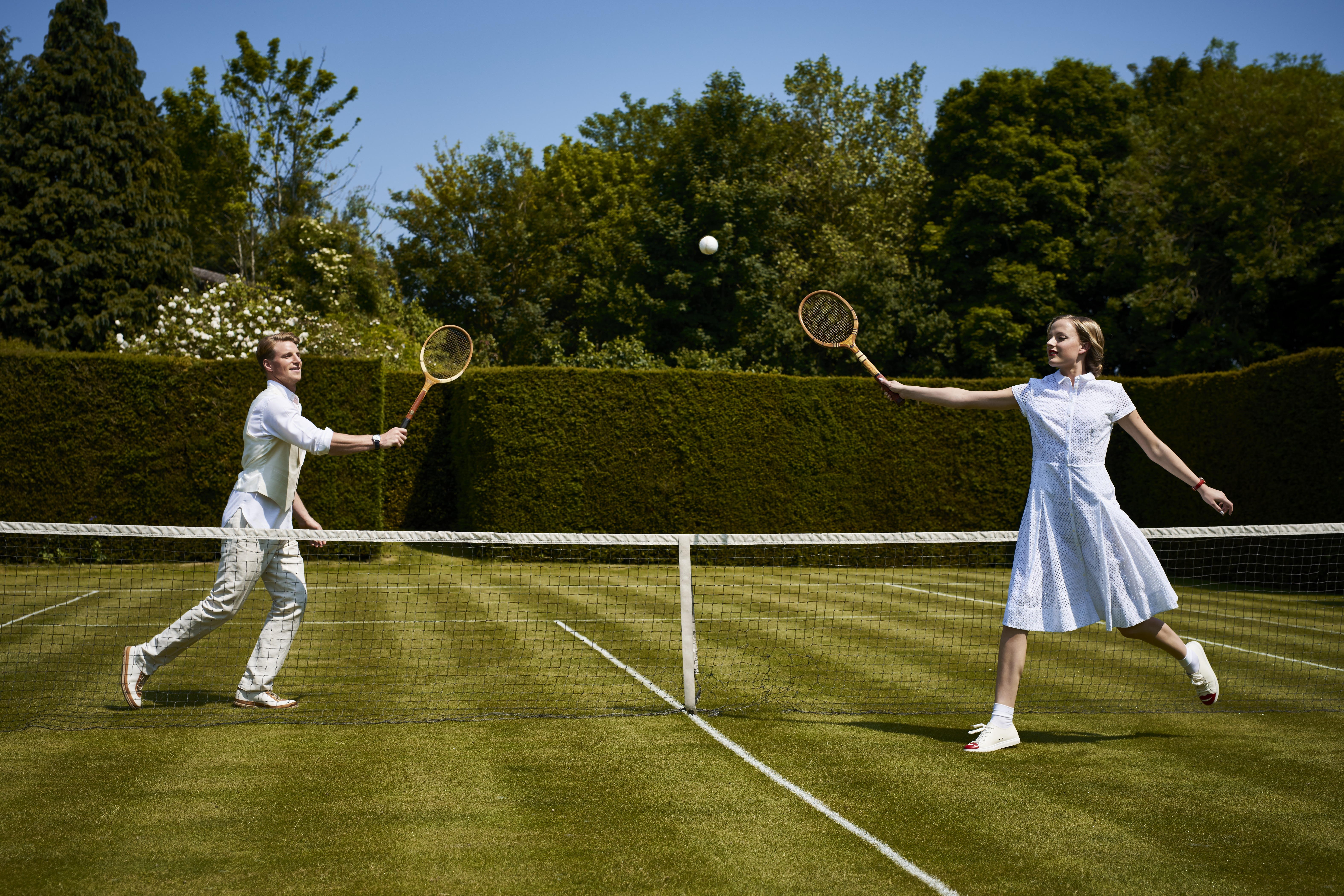See beautiful botanical pictures
Mark Griffiths enjoys a stunning exhibition of botanical paintings by Emma Tennant at the Fine Art Society


By Mark Griffiths
Years ago, when I used to commission botanical art for books and judge it at RHS shows, the ideal was akin to photo-realism, minutely observed detail immaculately reproduced. There was nothing wrong in that aim and many works aspiring to it were dazzlingly virtuosic and life-like. At the same time, I longed to see a complementary approach, one that was still accurate but more sparing with pen and brush, spontaneous seeming, dashing.
After all, images of this second kind filled Renaissance herbals and 19th-century publications such as Curtis’s Botanical Magazine; plant-explorers sketched them in notebooks; Japanese artists painted them on screens. Although simpler in technique, they could be more sophisticated in conception; rather than capture all of a plant’s characteristics, they focused on those establishing its identity and conveying its character. And, as art, they often had a stronger sense of design and personality, mood and moment.
All the while, one painter was producing work of exactly the kind I hoped for Emma Tennant, whose new exhibition, ‘Plants with Provenance’, is at the Fine Art Society this month. In horticulture and botany, provenance is no less important than in the art world. It encompasses where, how, when and by whom a plant was found or bred and introduced to science and cultivation.

Not only is this information invaluable in determining a species’ or variety’s identity and status within its kin, ecosystem and flora, but it also yields tales of discovery, characters from explorers to patrons and growers, and historical evidence of plants’ impact on society, gardens and wider culture.
For Miss Tennant, provenance is vital. ‘For decades,’ she tells me, ‘I’ve been collecting anything that strikes me as interesting about plants, any good story. I keep it all in a great card index primitive, but it works for me.’ Among the treasures in these files are the fruits of her archival research, anecdotes culled from generations of head gardeners, things observed during her years of chairing the National Trust’s Gardens Advisory Panel and field notes made on her travels to the temperate rain forests of southern Chile, for example, where, last winter, she found and painted the fabulous Philesia magellanica.
She draws on this material to produce essays on the works she exhibits. But her knowledge also plays an unseen role. She paints quickly and always from life; the results seem free and fresh, yet they’re rooted in expertise and inquiry. That’s partly why they’re so good. Other reasons include her quest for colour washes that combine substance with luminosity; the highly absorbent papers that she favours, one pearly off-white and Nepalese, the other fibrous, parchment-toned and Japanese; and the frames that she uses, some antique and veneered in rosewood or maple, others made by her daughter Isabel, a gilder.
Sign up for the Country Life Newsletter
Exquisite houses, the beauty of Nature, and how to get the most from your life, straight to your inbox.
Miss Tennant can’t recall a time when she wasn’t fascinated by plants and painting: ‘I must have been born with a trowel in one hand and a paintbrush in the other.’ For a child with such interests, her own provenance was propitious. The daughter of the 11th Duke of Devonshire, she grew up among the plants, gardens and related literature and records at Chatsworth House.
As a girl, her botanising was encouraged by her grandfather and her parents, who gave her Bentham and Hooker’s Handbook of the British Flora, which she took on expeditions among the local limestone dales. Over time, however, her most compelling guide would prove to be the spirit of the 6th Duke of Devonshire (d. 1858), whose patronage transformed British horticulture, botany and, ultimately, society through his protégé Sir Joseph Paxton.
Her new exhibition includes plants pioneered by these two giants. For example, there’s the exquisite orchid Calanthe vestita, a great Victorian favourite, but now exceedingly rare. Happily, it still flourishes at Chatsworth, never having left. Miss Tennant captures the romance that made it a hit and the delicacy that led to its decline. That’s her gift: portraying a plant as if seeing it for the first time, but also managing to intimate its personality and past, its provenance.
‘Plants with Provenance’ runs until December 10 at the Fine Art Society, 148, New Bond Street, London W1 (www. faslondon.com).
Country Life is unlike any other magazine: the only glossy weekly on the newsstand and the only magazine that has been guest-edited by HRH The King not once, but twice. It is a celebration of modern rural life and all its diverse joys and pleasures — that was first published in Queen Victoria's Diamond Jubilee year. Our eclectic mixture of witty and informative content — from the most up-to-date property news and commentary and a coveted glimpse inside some of the UK's best houses and gardens, to gardening, the arts and interior design, written by experts in their field — still cannot be found in print or online, anywhere else.
-
 J Rigg Construction
J Rigg ConstructionJ Rigg Construction specialises in delivering high-quality building and renovation services.
By Country Life
-
 New balls please: Eddie Redmayne, Anna Wintour and Laura Bailey on the sensory pleasures of playing tennis
New balls please: Eddie Redmayne, Anna Wintour and Laura Bailey on the sensory pleasures of playing tennisLittle beats the popping sound and rubbery smell of a new tube of tennis balls — even if you're a leading Hollywood actor.
By Deborah Nicholls-Lee